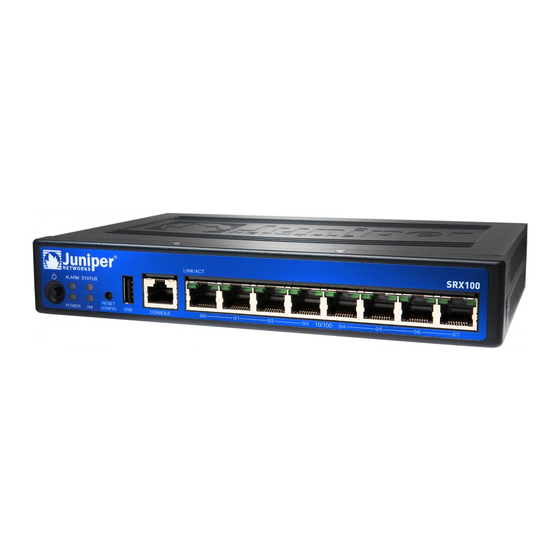
Juniper SRX100 Quick Start Manual
Hide thumbs
Also See for SRX100:
- Datasheet (17 pages) ,
- Hardware manual (154 pages) ,
- Quick start manual (2 pages)
Advertisement
Quick Links
SRX100 Services Gateway Quick Start
Use the instructions in this quick start to help you connect the SRX100 Services
Gateway to your network. For details, see the SRX100 Services Gateway Hardware
Guide at
http://www.juniper.net/techpubs/en_US/release-independent/junos/information-products/
pathway-pages/srx-series/product/index.html.
SRX100 Services Gateway Front Panel
Callout Description
Callout
1
Power button
4
2
LEDs: ALARM, POWER,
5
STATUS, HA
3
RESET CONFIG button
6
SRX100 Services Gateway Back Panel
Callout Description
1
Lock slot for security cable
2
Grounding point
Description
USB port
Console port
Fast Ethernet ports
Callout
Description
3
Cable tie holder
4
Power supply input
SRX100 Services Gateway Models
The following model of SRX100 Services Gateway is available:
Device
DDR Memory
SRX100H2
2 GB
Connecting and Configuring the SRX Series Device
Use the instructions below to connect and set up the SRX100 Services Gateway to
protect your network. Refer to the LEDs on the front of the device to help you determine
the status of the device.
Overview
The SRX100 Services Gateway requires these basic configuration settings to function
properly:
Interfaces must be assigned IP addresses.
Interfaces must be bound to zones.
Policies must be configured between zones to permit or deny traffic.
Source NAT rules must be set.
The device has the following default configuration set when you power it on for the first
time. You can use the device without performing any initial configuration.
Factory-Default Settings:
Port Label
Interface
Security Zone DHCP State
0/0
fe-0/0/0
untrust
0/1 to 0/7
fe-0/0/1 to fe-0/0/7
trust
Factory-Default Settings for Security Policies:
Source Zone
Destination Zone
trust
untrust
trust
trust
untrust
trust
Factory-Default Settings for NAT Rules:
Source Zone
Destination Zone
trust
untrust
NAND Flash Memory
2 GB
IP Address
client
unassigned
server
192.168.1.1/24
Policy Action
permit
permit
deny
Policy Action
source NAT to untrust zone
interface
Advertisement

Summary of Contents for Juniper SRX100
- Page 1 SRX100 Services Gateway Quick Start SRX100 Services Gateway Models Use the instructions in this quick start to help you connect the SRX100 Services Gateway to your network. For details, see the SRX100 Services Gateway Hardware Guide at The following model of SRX100 Services Gateway is available: http://www.juniper.net/techpubs/en_US/release-independent/junos/information-products/...
- Page 2 Wait until the STATUS LED is solid green before proceeding to the next task. 192.168.1.1/24. When an SRX100 Services Gateway is powered on for the first time, it boots using Task 2: Connect the Management Device the factory-default configuration.
- Page 3 From the Device Information page of the wizard, type the following information: Select one of the following icons that best identifies your experience level, and click Device name of the services gateway; for example, SRX100. Next: Enter and confirm the root password.
- Page 4 Configure the security topology: NOTE: The wizard recommends destination NAT rules based on the enabled zone services in the DMZ or internal topology. From the Security Topology Overview page, click Next. The Internet Zone Setup Page appears. From the Network Address Translation Overview page, click Next. The Internal Source NAT page appears.
-
Page 5: Powering Off The Device
Task 9: Verify the Configuration To reset the device to the rescue configuration, briefly press and release the Reset Access http://www.juniper.net to ensure that you are connected to the internet. This Config button. The device loads and commits the rescue configuration. - Page 6 Juniper Networks, Inc. All other trademarks, service marks, registered trademarks, or registered service marks are the property of their respective owners. Juniper Networks assumes no responsibility for any inaccuracies in this document. Juniper Networks reserves the right to change, modify, transfer, or otherwise revise this publication without notice. Products made or sold by Juniper Networks or components thereof might be covered by one or more of the following patents that are owned by or licensed to Juniper Networks: U.S.













Need help?
Do you have a question about the SRX100 and is the answer not in the manual?
Questions and answers